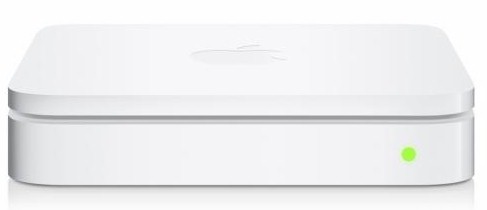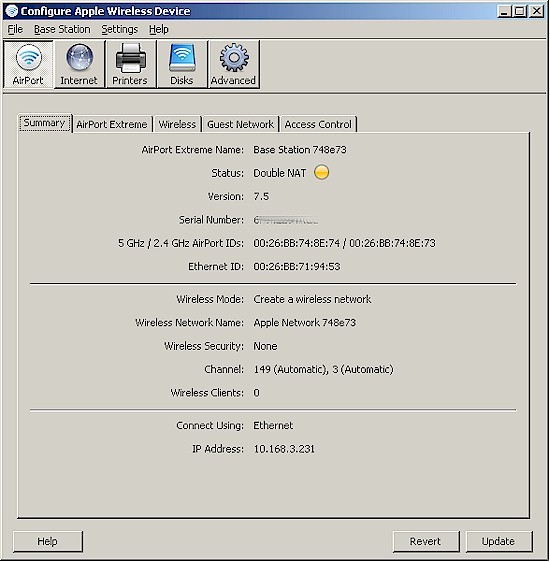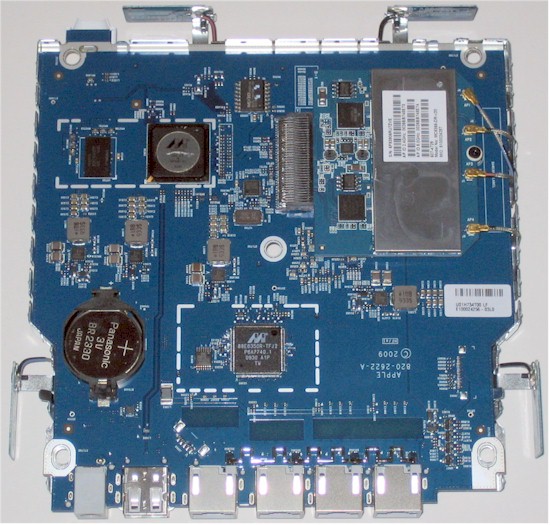
| At a glance | |
|---|---|
| Product | Apple Airport Extreme Base Station – Simultaneous Dual Band (MC340LL/A) [Website] |
| Summary | Latest version of Apple’s 802.11n router with disappointing wireless performance. |
| Pros | • Two radios for simultaneous dual-band operation • High routing speed |
| Cons | • No web administration • Poor wireless range performance • Can’t use 40 MHz mode in 2.4 GHz • No jumbo frame support • Disk sharing choked on 1 GB file transfer |
Typical Price: $90 Buy From Amazon
Introduction
Update 11/13/2009: Added link to follow-up article
Well, it turns out that Apple never even responded to my review request this time. But my curiousity about whether Apple was performing a stealth seeding of three-stream routers in the the wild got the better of me. So I broke down and bought the new MC340LL/A model to see for myself and ended up disappointed on multiple counts.
As soon as I cracked the case, I knew that my three-stream guess was wrong. Figure 1 shows only four antennas, which makes two per radio. And since three-stream routers require three transmit and receive chains, the new Extreme won’t be getting a three-stream upgrade sometime in the future.
Figure 1: Inside the new Airport Extreme Simultaneous
I was also wrong in my guess that Apple just slipped a new radio module into the old dual-radio Extreme. The previous article showed that the previous Extreme used two Atheros single-chip N radios: an AR9220 dual-band, 2×2 for 5 GHz; and an AR9223 single-band, 2×2 for 2.4 GHz on a mini-PCI module.
Once I got the main board freed from the thermal tape that bonds it to the heat sink blocks, which, in turn, sit on a combination RF shield / heatsink that covers the top of the router, the view shown in Figure 4 was revealed.
Figure 2: New Airport Extreme Simultaneous board
This is actually an entirely new board, with an all-Marvell design (processor, switch, radios) and more RAM. The new processor is a Marvell 88F6281 1.2 GHz "Kirkwood", which is a popular choice in current-generation NASes, instead of the 88F5181 in the previous model. The switch is now a Marvell 88E6350R 7 Port Gigabit. But Apple’s case design still allows only one WAN and three LAN ports to be exposed, none of which support jumbo frames.
RAM has been increased from 64 to 128 MB, but flash stayed the same at 16 MB. Note the big ol’ button-cell battery, I guess to keep info alive in RAM. A glance at the bottom of the board revealed a Pericom PI7C9X20303UL PCIe Packet Switch, which I assume helps connect the new radio module to the CPU.
I didn’t take the shield off the radio module, so was only able to see the two Marvell 88W8366 devices visible in the photo. Since Marvell keeps details on its devices to itself and its customers, I don’t know anything about these devices. But two antenna connections per radio says that it’s a dual-stream-only design.
Features
Apple still marches to its own tune in its refusal to put a web admin interface on the Extreme. The latest version of the AirPort utility (5.5) now requires Win XP SP3 or Vista (if you’re not running Mac OS), which was an annoyance when I tried to install the utility on an XP SP2 system.
Figure 3 shows the Summary screen, which shows that the Extreme can detect when another router is sitting between it and the Internet (Double NAT status).

Figure 3: AirPort Utility Summary screen
The Extreme’s feature set has stayed largely the same since we reviewed the original Draft N model. The main differences are the addition of a wireless Guest Network feature, support for the second radio and support for IPv6.
But don’t expect the Extreme to be like other dual-band, dual-radio N routers. First, the Guest Network runs on the 2.4 GHz band only, although it can have its own wireless security settings.
You also shouldn’t bother trying to find the setting to enable 40 MHz channel width mode in the 2.4 GHz band—Apple still has it locked out. Even Intel has backed off on the no-40 MHz-for-you-in-2.4 GHz policy in its original 4965 AGN 11n adapters, allowing it to be enabled in the newer 5100 and 5300 AGNs. Perhaps its time for Apple to take a similar path. While I still think hogging bandwidth in 2.4 GHz isn’t a neighborly thing to do, there are some cases when it might be helpful.
When it came time to check to see if the Extreme dropped to 11g rates when using WEP or WPA/TKIP, I ended up not being able to run the tests. No matter what I tried, I could not force the Extreme to allow only WPA/TKIP connections, nor could I get it to allow WEP only.
Speaking of WEP, I wasn’t able to even find it among the Wireless Security options. And a search through the PDF User Guide didn’t yield even a single hit. When a search in Apple’s Support database also didn’t come back with anything obvious, I finally turned to Google. But even that didn’t come up with an obvious solution right away.
I finally found an obscure discussion group post that revealed that I needed to press the Control key while clicking the Wireless Security dropdown in the Windows version of the utility or the Apple key in the Mac OS version. This then exposed WEP, which was marked as a "Transitional Security Network".
But even then, WEP testing was not to be. Despite repeated attempts, I could not get the Extreme to allow WEP-only connections and my client insisted on connecting via WPA2 / AES. Note also that I could only enter thirteen characters, even when I tried the $ Hex Escape character. So good luck if you’re trying to use a 128 Bit WEP key with the Extreme.
I also found that the Extreme doesn’t support automatic wireless security setup via Wi-Fi Protected Setup, which is surprising given Apple’s focus on ease of use. And finally, if you want separate wireless security settings for each radio, you’ll need to choose another product. The Wireless Security controls apply to both radios.
Another area where I wasn’t able to complete testing was measuring the performance of the USB drive sharing feature. I was able to get the FAT-formatted disk to be recognized and mapped to my Vista SP1 test system. But when I ran the robocopy routine, which copies a folder of files from a ripped DVD, the connection locked up when the copy got to a 1 GB VOB file. I also tried just drag-and-dropping the 1 GB file itself and gave up the test when it also locked up.
Routing Performance
Table 1 shows that the new Extreme’s routing speed has had a significant boost from the original, single radio version, with over 400 Mbps for download and 300 Mbps upload. Maximum simultaneous sessions aren’t top-notch, however. I was able to reliably get only 128 sessions to complete the one minute test. This is in contrast with most new routers, which hit the maximum test limit of 200 connections on the first try.
| Test Description | Throughput – (Mbps) | Original Extreme Throughput – (Mbps) |
|---|---|---|
| WAN – LAN | 419.5 | 132.7 |
| LAN – WAN | 330.7 | 125.5 |
| Total Simultaneous | 414.7 | 124 |
| Max. Connections | 128 | 128 |
| Firmware Version | 7.5 | 7.2.1 |
Table 1: Routing throughput
Figure 4 shows the IxChariot aggregate plots for WAN to LAN, LAN to WAN and simultaneous routing throughput tests, which look nice and steady.
Figure 4: Apple Airport Extreme routing throughput
Wireless Performance
I used the open air test method described here to test the Extreme’s wireless performance. Testing was done using our standard wireless test client, an Intel Wi-Fi Link 5300 AGN mini-PCIe card in a Dell Mini 12 running WinXP Home SP3. Since Intel continues to update the 5300’s drivers, I periodically check for updates and found one. So I upgraded the driver to XP version 13.0.0.107. I left all client-side defaults in place except for enabling throughput enhancement (packet bursting).
The Extreme had the latest 7.5 firmware loaded and all factory default settings in place, except setting channel 1 for the 2.4 GHz band and channel 36 for 5 GHz.
I don’t have open air method results for the original Extreme because it was tested using the Azimuth method. But the original Extreme still tops the Azimuth method 2.4 GHz charts with average throughput in the 55 – 60 Mbps range for down and uplink.
5 GHz performance was not so great, however, with average throughput in the high-20 to mid-30 Mbps with 20 MHz channel bandwidth and not much better in 40 MHz channel mode.
Figure 5 shows the new Extreme’s rankings in the 2.4 GHz Wireless Charts for the average downlink throughput tests with only dual-band routers selected. I was as surprised as you are to see the new Extreme rank so low, with only 25 Mbps average downlink throughput. I’m not showing the uplink ranking; it’s just about the same with 25 Mbps average throughput.

Figure 5: 2.4 GHz, 20 MHz mode average throughput chart
Figure 6 shows the 5 GHz downlink rankings, again with just dual-band routers selected. The Extreme still averages in the mid-20 Mbps for downlink, but manages to move up to the top of the 5 GHz uplink chart, beating even the NETGEAR WNDR3700, with an 33 Mbps average throughput.

Figure 6: 5 GHz, 20 MHz mode average throughput chart
Averages can hide a multitude of sins (and strengths). So for a better comparison, I’ll use the new Wireless Charts Performance Table to compare the new Extreme with the NETGEAR WNDR3700, Cisco / Linksys WRT400N and D-Link DIR-825 B1.
The Performance Table gathers all the average throughput test results for the selected adapters into a single table. It then highlights the highest throughput value in each Test location for each benchmark test. If results are within 1.0 Mbps of each other then both products’ results are highlighted. Finally, the number of highlighted results are tallied for each test group and the product name with the most highlighted values is then highlighted.
You’ll note that the Table has been changed so that results are separated for each band and channel bandwidth mode (20 and 40 MHz), which makes for a more detailed comparison.
Figure 7: Wireless Performance Comparison – 2.4 GHz
Figure 7 summarizes the 2.4 Ghz band results and Figure 8, the 5 GHz band. (Click each image to see all the tests in each group.)
No product sweeps all the tests. But the WNDR3700 does the best, winning four out of eight test groups and tying in two more. The Linksys WRT410N and Extreme tie for second, each winning one test grouping and tying another. The D-Link DIR-825 B1 is the only loser, with no wins in any grouping.
Figure 8: Wireless Performance Comparison – 5 GHz
Wireless Performance- more
It’s easy to get lost in the data, so let me point out some particular weaknesses in the new Extreme’s wireless performance. As previously noted, the Extreme has its 40 MHz channel mode locked out in 2.4 GHz, so you see no results for those tests.
But you may have missed the 0 Mbps results in the 2.4 GHz band, Location F. The Extreme had a tenuous hold on its connection in Location E, which resulted in ~ 1 Mbps of speed. But when I moved to Location F, only about 6 feet away, I wasn’t able to get a good enough connection to run the test.
Update 11/13/2009
An explanation for the poor 2.4 GHz performance can be found here.
Like all other N products, I wasn’t even able to see the 5 GHz radio once I moved beyond test Location D.
Highest 2.4 GHz band throughput for the Extreme was 72.5 Mbps running uplink with 20 MHz channel bandwidth in Location A. Highest 5 GHz band speed was 99.1 Mbps also running uplink, but with 40 MHz channel bandwidth in Location A.
Figure 9 shows the summary plot of IxChariot tests for 2.4 GHz downlink tests with a 20 MHz channel width. Throughput is relatively stable, but with some large dropouts.
Figure 9: Six location wireless throughput – 2.4 GHz, 20 MHz bandwidth
Here are the other composite IxChariot plots if you’d like to look:
Maximum Wireless Performance
I ran the same check used on the WNDR3700 and DIR-825 B1 to see how the Extreme performed when I ran four TCP/IP streams simultaneously on each radio. I set up a second notebook using a NETGEAR WNDA3100v2 client connected to the 5 GHz radio and my standard Intel 5300-equipped notebook connected to the 2.4 GHz radio.
Both clients were in the same room, within 10 feet of the router with the 2.4 GHz radio in the only-available 20 MHz bandwidth mode and the 5 GHz radio set to 40 MHz channel bandwidth mode.
Figure 10 shows that the new Extreme was only able to provide about 100 Mbps of total throughput through both radios running downlink
Figure 10: New Airport Extreme aggregate wireless throughput – downlink
Figure 11 shows the uplink results, with 221 Mbps of aggregate throughput, more than 2X download results. Why the big difference? Beats me.
Figure 11: New Airport Extreme aggregate wireless throughput – uplink
For reference, the WNDR3700 yielded 252 Mbps total downstream and 262 Mbps upstream. So the new Extreme is definitely not best-in-class when it comes to total wireless throughput.
Closing Thoughts
I didn’t test the previous, Atheros-based simultaneous dual-band Extreme, so I don’t know if my results are indicative of the "50 percent better Wi-Fi performance and up to 25 percent better range than with the previous-generation AirPort Extreme Base Station" that Apple claims for this new version. If they are, then I’m glad I didn’t waste my money on that version, although I’m not really pleased that I’m out around $200 (including shipping) for this one.
At any rate, Apple’s decision to move to Marvell for the latest version of the Extreme seems to be ill-advised since 2.4 GHz range is lower than other current-generation dual-band routers and total wireless downlink throughput is no match for the NETGEAR WNDR3700. Given that I haven’t seen Marvell in any other new N router designs, and Atheros is in so many, including the NETGEAR WNDR3700, I’m at a loss to explain Apple’s choice.
But performance aside, the Extreme’s routing feature set is pretty poor compared to current-generation products. Port forwarding is limited, triggered forwarding isn’t supported, there is no port or keyword filtering and no QoS, automatic or even manual. And I’ve already pointed out the wireless feature weaknesses, which are just plain annoying and border on the paternalistic.
Finally, I encountered the same problem reported by other Airport owners during testing. I forget exactly when, but at one point, the AirPort Utility was no longer able to find the Extreme during its scan. I tried soft and hard resets, power cycling, and even taking out the battery for awhile to try to clear what ailed it, but to no avail.
I would have tried a firmware download, but a 7.5 download was nowhere to be found on either the supplied CD or Apple’s support site. Nor was any indication of a fix for this problem in Apple’s online knowledge base. So for the latter part of my testing, I had to use the Utility’s Configure Other mode, which wasn’t even helpful enough to remember the Airport’s IP after I typed it in. Given all of the Extreme’s other frustrating "features", this was just icing on the cake.
In sum, there is no reason that I can think of to recommend the new Airport Extreme.
 Buy Airport Extreme Base Station – Simultaneous Dual Band from Amazon
Buy Airport Extreme Base Station – Simultaneous Dual Band from Amazon








